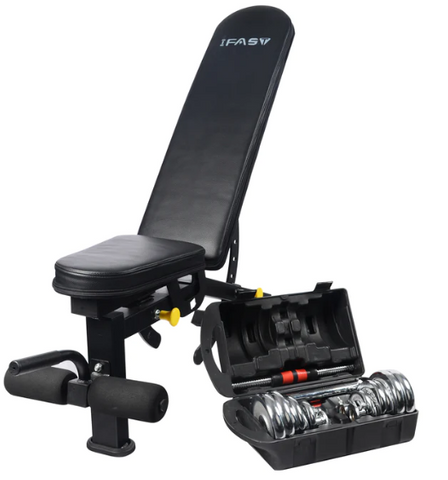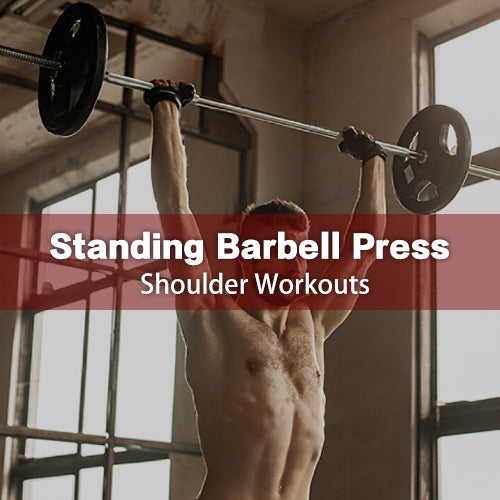When it comes to dumbbell fly, we believe that most fitness people are familiar with it. Whether it is training in the gym or doing bodyweight training at home, it seems that the frequency of dumbbell fly training has always been relatively high. Of course, from this point, we can see that the training effect of this training action is obvious.
So if you add this training action to your fitness training plan, you can’t go wrong after all, so here we suggest that if you want to practice this training action, you might as well have a brief understanding of some basic common sense of this training action before practicing, for example, what is the standard action for dumbbell fly? What are the benefits? All of these require a simple understanding, so let's discuss them together.
Here you will know:
- How to Do a Dumbbell Fly?
- Dumbbell Fly Benefits
- What Does Dumbbell Fly Work?
- Who Should Do Dumbbell Fly?
- How to Schedule Dumbbell Fly?
- Dumbbell Fly Variations
So, without wasting any further time, let's get into the article.
How to Do a Dumbbell Fly: Flat bench dumbbell fly is an example

1.Preparation: Lie on your back on a narrow bench (20-25 cm wide), and hold a bell with both hands, palms facing each other. The upper back is close to the stool, the spine is bent physiologically, and the core is tightened!
2.Lowering: When lowering the dumbbells, focus on the chest seam, rely on the tension of the pectoral muscles to control the dumbbells to lower slowly, and at the same time fully inhale and raise the chest, and the range should be fully in place.
3.Contraction: When lifting, rely on the contraction of the chest muscles to drive the arms to embrace upwards until the dumbbells touch, to avoid excessive participation of the shoulders and backs.
4.Mind concentration: focus on the chest muscles and feel the chest muscles being pulled and contracted. To make the movement more accurate, imagine hugging a big pillar, and keep thinking about holding it in your heart when doing this movement! hold it! "Try it
Dumbbell Fly Benefits
For most guys, three benefits can be gained from using a dumbbell fly in training.
1.Increase chest muscle hypertrophy/circumference
Isolation exercises are a great way to further increase the mobility of muscles and those specific muscles that cannot be additionally loaded by a compound multi-joint bench press training program. Adding dumbbell fly to your routine is a great way to add muscle work that will help you strengthen your chest size and strength potential.

2.Increase the dimension of chest muscle training
Dumbbell fly are a valuable exercise that can add another dimension to chest training, often helping to maximize overall pectoral size, detail and growth. Multi-angle dumbbell fly can also help further stimulate new muscle fibers and hypertrophy.
3.Stimulate the chest muscles in isolation
While we often discuss multijoint compound movements for optimal strength and athletic performance, dumbbell fly is valuable if you're trying to specifically target your pecs with dumbbell exercises for further development or injury prevention.
Using dumbbell fly (and other flye variations/alternatives) can help with both of the above goals, while also minimizing (often encountered with some compound pressing movements) the stress on the triceps, and elbows, Excessive wear and even risk of tearing on the neck, wrists and shoulders.
What Does Dumbbell Fly Work?
Dumbbell fly are an isolation exercise that can be used to increase chest muscle mass. Let's analyze the muscles involved in the dumbbell fly.

1.Pectoralis major
The target muscle for the dumbbell fly is the pectoralis major. It is this single-joint movement that the dumbbell flye can be used to specifically isolate the pectoral fibers, with minimal involvement of other supporting muscles during the movement.
2.Front deltoid
While the anterior deltoids aren't the primary muscle group in the dumbbell flye, they support the pecs during this movement.
3.Scapular Stabilizer Muscles
The scapula stabilizer muscles are active in dumbbell fly because they are needed to stabilize the shoulder during the movement to help stabilize the shoulder joint. Without properly stabilized shoulders, the anterior deltoids can be recruited more than the pecs, reducing the efficiency of the dumbbell fly.
Who Should Do Dumbbell Fly?
1.Strength athletes
Professional athletes who engage in strength and sports that require strength can benefit from dumbbell fly for pec hypertrophy and muscle growth. In addition to being used to strengthen the bench press, the dumbbell fly can also be used to improve power production and pectoral end-range strength and aid in recovery from injury.
2.Bodybuilders
The dumbbell fly is a powerful single-joint chest exercise that can be used to increase the development of pectoral hypertrophy. Can be done after major heavy lifts to maximize muscle fiber destruction. In addition, a dumbbell fly can also be arranged at the beginning of the training to pre-fatigue the muscles and help activate the chest muscles to stimulate muscle growth.
3.General health purposes
Most fitness programs benefit from multi-joint, compound movements that maximize muscle growth and metabolic stress. Therefore, dumbbell fly are not indispensable in the training plan.
How to Schedule Dumbbell Fly?
The following are three main training objectives and scheduling recommendations. These are general guidelines and should never be used as the only way to plan.
1.General strength training - reps and sets
For general strength training, do more sets with fewer reps. Note that heavy loads can easily strain the shoulders and pectorals, and you should only carefully attempt heavier fly after you've mastered the technique with lighter weights.
Groups: 4-6 groups; Frequency: 4-6 times; Rest between groups: 60-90 seconds
2.Muscle hypertrophy reps and sets
To increase muscle size and hypertrophy, use the following rep approach.
Number of sets: 4-6 sets; Number of times: 8-12; Rest between sets: 60-90 seconds (medium to heavy weight training)
3.Muscle Endurance - Reps and Sets
To train greater muscular endurance, we recommend higher reps and/or shorter rest periods.
Number of groups: 2-3 groups; Frequency: more than 12 times; Rest between groups: 60-90 seconds
5 Dumbbell Fly Variations
Incline Dumbbell Fly

The incline dumbbell fly is to change the inclination according to the adjustment of the backrest when doing the dumbbell fly, and the training focus shifts from the middle area of the pectoral muscles to the upper part of the pectoral muscles. The incline dumbbell fly is one of those exercises that focuses on isolating the upper pecs while also targeting the front deltoids.
Similarly, as the inclination moves up, the key area of stimulation begins to shift to the upper part of the pectoral muscles. When the inclination angle of the backrest is adjusted to be 30-45 degrees from the ground plane, the upper part of the pectoral muscles is best stimulated.
Step 1: Preparing for action
Adjust the dumbbell bench so that the inclined board is 30 to 45 degrees from the ground, lie on your back on the bench, and grasp the dumbbells with both hands, palms facing each other. Keep your upper back against the stool, keep your spine in a natural curve, and keep your core engaged. Keep your feet firmly on the ground, keeping your elbows slightly bent.
Step 2: Decentralization process
When lowering the dumbbell, focus on the middle seam of the chest, rely on the tension of the pectoral muscles to control the dumbbell to lower slowly, draw a large fan-shaped arc, and bend the elbow slightly during the movement (to protect the elbow joint). Lower it until you can stretch your pectoralis major to the greatest extent. After the dumbbells are lowered to the lowest point, stop for a while; it should be noted that the range of motion should be in place. At the same time, fully inhale and raise your chest.
Step 3: Upward shrinkage process
When going up, rely on the contraction of the chest muscles to drive the arms to embrace upwards, to the starting position, and repeat the movement.
Decline Dumbbell Fly

Decline dumbbell fly stimulates the underside of the pecs through a change in position.
Step 1: Preparing for action Tilt the dumbbell chair down 15-30°, lie on your back on the chair, hold the dumbbell with both hands and lift it, with your elbows slightly bent.
Step 2: Action process Bend your elbows slightly and lower them to the backplane, pause for 2 seconds. Lift it to your chest along a certain arc. Keep your arms and shoulders in the same plane the entire time.
Bent Over Dumbbell Fly

The bent-over dumbbell fly is a classic exercise for the rear delts
Step 1: Preparing for the action. The feet are naturally separated and shoulder-width apart, the upper body is leaned forward about 60°, the knees are slightly bent, and the dumbbells are held in both hands, hanging in front of the knees.
Step 2: During the movement, keep your back straight, tighten your abdomen, keep your arms slightly bent and lift the dumbbells, keep your upper arms and back level, and stay for 1-2 seconds.
Step 3: Restoring the action Control the dumbbells with both arms and slowly return to the ready action, do 3-6 groups, 4-8 times in each group.
Dumbbell Floor Fly

To do a flat dumbbell fly, we need to lie flat on the training mat.
Step 1: The preparation action is similar to sit-ups. You need to bend your knees, step on your feet, hold a small dumbbell in each hand, straighten your arms, and be on the same level as your shoulders.
Step 2: Then raise the dumbbells directly above your chest, with your fists facing each other and your arms straight.
Step 3: After the preparation is done, we open our arms, lower the dumbbells near the ground, pause for a while, and then return to the starting position.
Dumbbell Fly-On Exercise Ball

A dumbbell fly-on exercise ball is a strength exercise that works the deltoids, pectorals, rear deltoids, lateral deltoids, and upper pecs.
Begin sitting on a stability ball with a dumbbell in each hand. Roll back so that your upper back is completely against the ball.
Press the dumbbells in front of you with a slight bend in your elbows. Draw the arms back in a wide arc by squeezing the chest and moving at the shoulder joints.
Hold for a moment before exhaling back.
You can also refer to our
IFAST Dumbbell and Weight Bench
Click and Shop 👉here



